What is their role in our habitat garden? Should we welcome them or not?
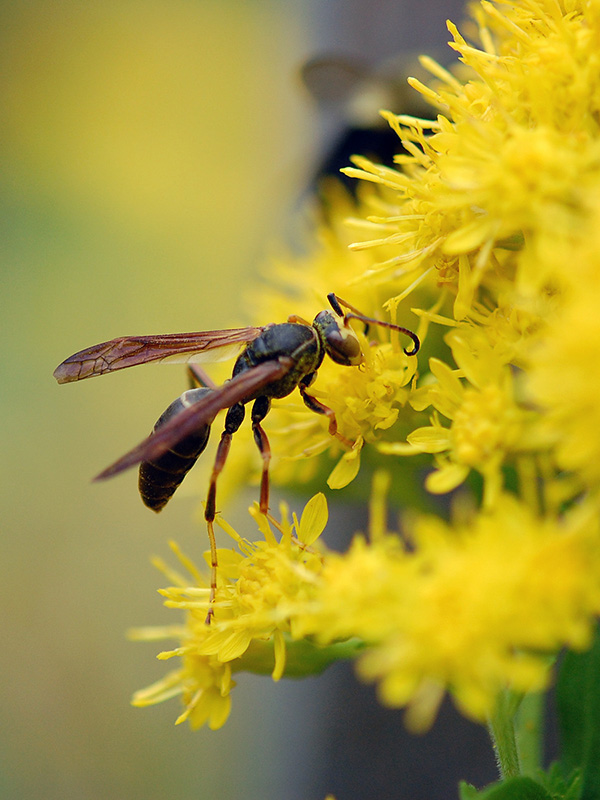
We know that bees (and bee-mimicking flies) are excellent pollinators, but we’ve often wondered about wasps, such as yellow jackets and hornets — the closest relatives of bees.
Unlike bees, which have a vegetarian diet, in their larval stage wasps are carnivores.
When they’re adults, they feed on nectar from shallow flowers since their tongues are much shorter than bee tongues.
Are wasps good pollinators? If you compare bumble bees and wasps, one important difference is that unlike bumble bees, wasps aren’t covered with hairs that collect pollen. So, they aren’t an important pollinator BUT they do play an important role in controlling other insects.
As The Xerces Society says, “With a few notable exceptions (such as bald-faced hornets and yellowjackets), wasps are gentle insects that do not typically sting people. Wasps make important ecological contributions by controlling pest insects.”
We have certainly found wasps to be gentle and approachable insects, and we welcome them into our yard.
Some notable ones are below and a more complete gallery of wasps I’ve seen in our yard.
An attention-getter
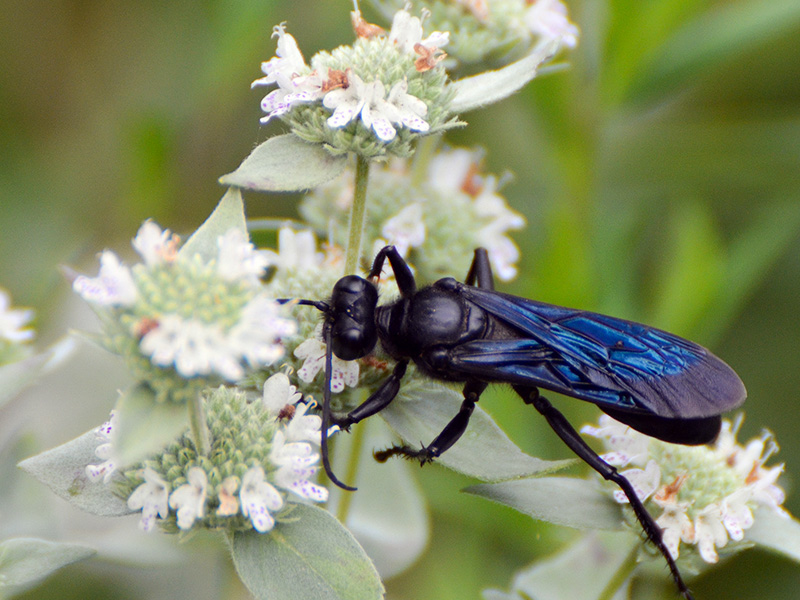
One of our favorites is the great black digger wasp (Sphex pensylvanicus), also known as the steel blue cricket-hunter. (More photos of this wasp are on our Wasps page.)
I love seeing their steely blue-black color. As plentiful as they are in our yard and as often as I get close to watch it or photograph it, I’ve never had a problem being close to it. As a solitary wasp, it isn’t aggressive. In fact, only the female is capable of stinging, and they’re preoccupied with foraging. So why are there so many internet searches on how to get rid of them?
Yellow jackets
Yellow jackets are a type of wasp, not a bee, and though they do pollinate, they aren’t prime pollinators. They’re important carnivores, though, and keep down the population of caterpillars and other insects. Of course, they aren’t going to distinguish between my butterfly caterpillars and caterpillars that munch on our vegetable garden plants, but I can’t control that. It wouldn’t be a problem in a world that had a healthy balance of nature!
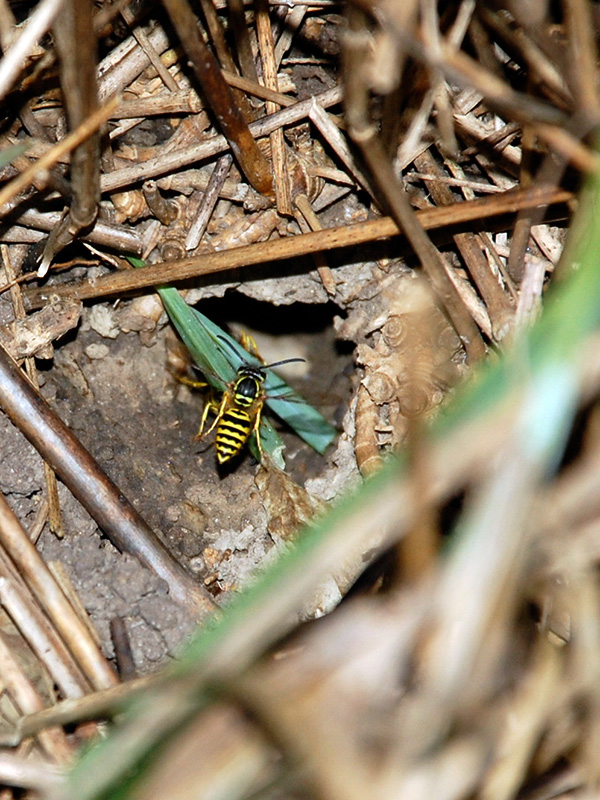
This yellow jacket is taking some grass down into the hole. When I first spotted this nest, I was concerned. Yellow jackets have a reputation for aggressively defending their nest, and it was in a high-traffic area of our backyard: the native grass triangle right next to the main path to our backyard.
Still, I didn’t want to automatically decide to eradicate the nest. We watched — from a safe distance — and waited.
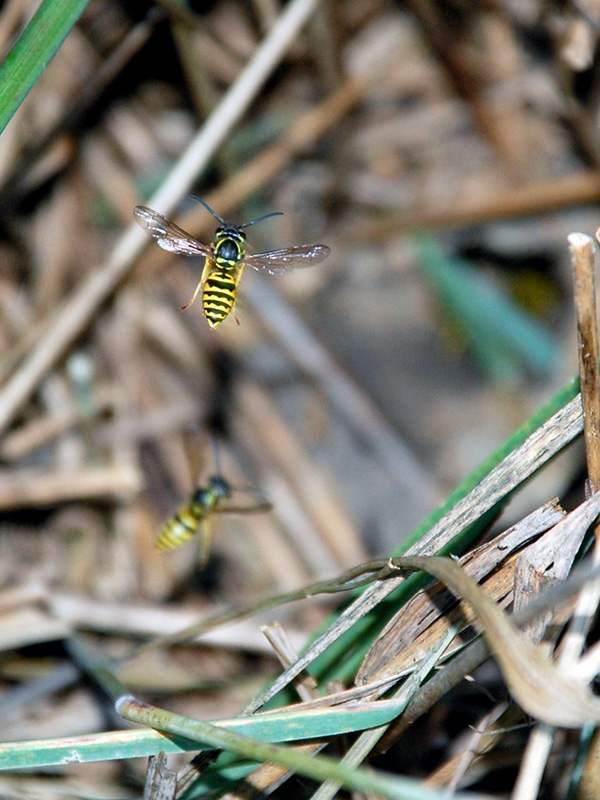
It turned out that we were able to peacefully coexist the summer they nested so close to our back door, though I kept my distance. There certainly was a lot of activity going in and out of the hole.
All in all, I’m glad we let them stay, but I was happy they didn’t return to this particular site, so close to where we walk.
Hornets
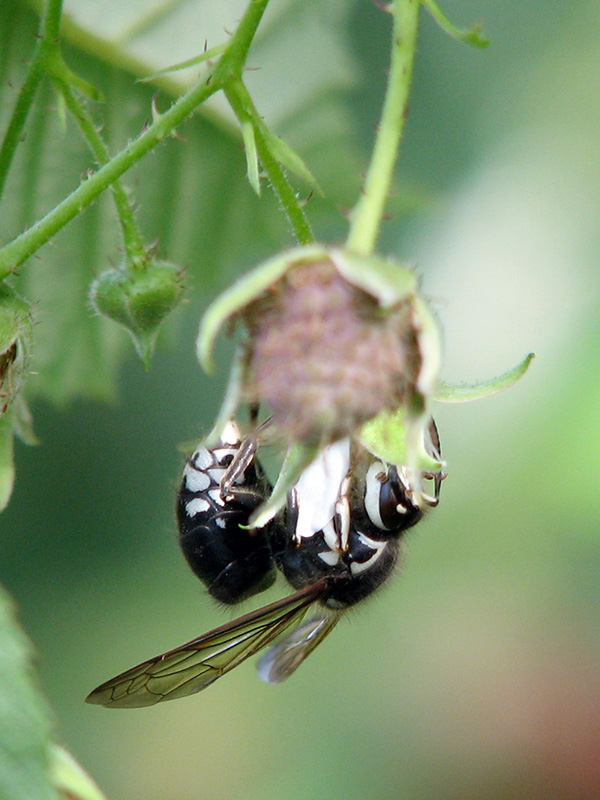
We frequently see bald-faced hornets foraging in our raspberries, as well as in other places in our yard.
Hornets have a reputation for aggressiveness, but I’ve read they’re not aggressive when foraging, only when they’re defending their hive. This has certainly been the case for us.
AND it’s important to note that bald-faced hornets are not true hornets, but rather a type of aerial yellowjacket (even though it’s not yellow).
They’re considered a beneficial insect since they control populations of unwanted insects and pollinate flowers.
I don’t know where this bald-faced hornet’s nest was, but I don’t think it was in our yard. At least I never saw one during the summer or even in the winter or fall when it would be easier to spot.
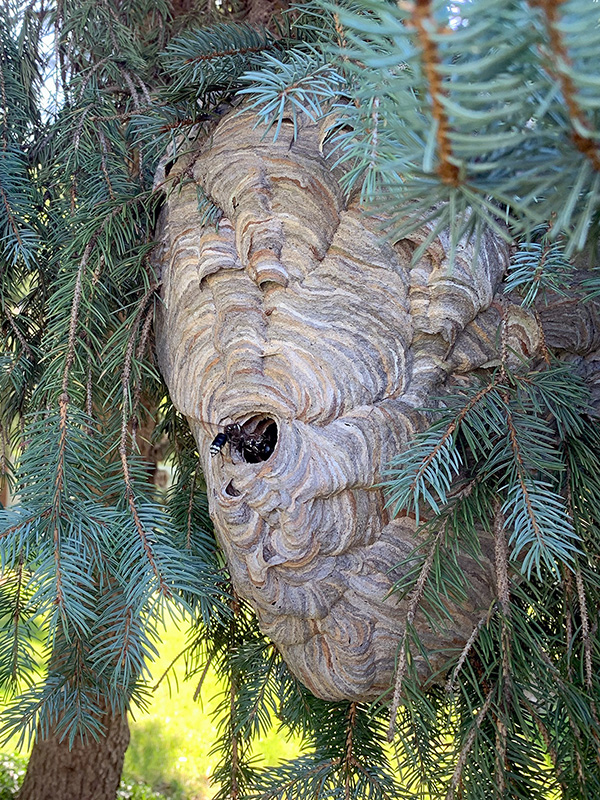
We saw this beautiful hornet’s nest — complete with hornet entering the hole! — in someone’s front yard as we were walking through the neighborhood. It was very visible, so I’m sure the owners knew it was there and have decided to co-exist with it.
- Learn more:
- Penn State Extension: Baldfaced hornet
Resources
- Xerces Society:
- USDA Forest Service:
- Pollen wasps – superficially yellow jacket-like; collect nectar and pollen
- NY Times:
- Joe Gardener from Growing a Greener World:
- Fascinating world of wasps with Heather Holm – article and podcast
- BOOKS:
- Holm, Heather – Wasps: Their Biology, Diversity, and Role as Beneficial Insects and Pollinators of Native Plants (2021)
- Grissell, Eric – Bees, Wasps, and Ants: The Indispensable Role of Hymenoptera in Gardens (2010)
- YouTube:
- Humane Gardener:
Reflections
A terror of the garden, the yellow jacket is a social wasp (along with hornets and paper wasps). For the most part, gardeners don’t even know these predators are around, but disturb the nest badly enough and there is hell to pay. I have wandered past nests in my garden, in complete ignorance, without the least worry. It is only when I become aware of the nest that the wasps seem to become aware of me.
~ , Insects and Gardens: In Pursuit of a Garden Ecology, p. 291, 2001
The chances are high that no one will want to encourage the social wasps, and I basically agree with this. We think nothing of them, as long as we don’t see the nest. But as soon as we do, some killing instinct in our psyche arises and we douse the whole colony with gasoline or noxious chemicals.
I will not belabor the point, but even I would not insist that you make houses for the likes of yellow jackets or hornets.
Alternatively, I simply ask that when you see a nest already in place, consider the total biological picture before you run for the gas can. In mid to late summer, if you find a nest next to the pathway, chances are it was there the whole time and didn’t bother you at all. You shouldn’t think just because you have found a nest that its occupants, by some strict code of wasp ethics, are now required to kill you.
On the subject of solitary wasps, however, I do insist that you allow these maligned creatures a chance to live in your garden.
~ , Insects and Gardens: In Pursuit of a Garden Ecology, p. 277, 2001
